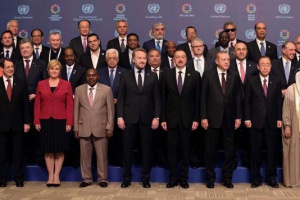Seychelles' vice president promotes new aid architecture at World Humanitarian Summit
Diplomacy |Author: Patsy Athanase and Sharon Uranie | May 24, 2016, Tuesday @ 14:41| 13558 views
Group photo of delegates including Seychelles Vice President Danny Faure attending the two-day World Humanitarian Summit, taking place since Monday in Istanbul, Turkey. (State House)
(Seychelles News Agency) - Although Seychelles remains vulnerable to various humanitarian crises, the country has embraced a people-centred development model that has empowered the population to deal with emergencies, the country's vice president said.
Vice President Danny Faure said this on Monday while addressing the plenary session of the first ever World Humanitarian Summit in Istanbul, Turkey.
“This model of development has delivered a robust system because a well-educated, well-informed and healthy population is resilient to adverse situations,” said Faure.
The 115-island archipelago in the western Indian Ocean remains vulnerable to various humanitarian crises. This includes intensifying cyclones, rising sea levels and ocean acidification, all due to climate change. All three can lead to loss of habitat and livelihood.
Faure noted that empowering people to be first responders when disasters strike increases the effectiveness of assistance provided by the government and international community.
“It also improves their adaptability, as they are better equipped to deal with change in their habitat and livelihood,” Faure concluded.
The Istanbul summit is seeking to improve the way aid is given and improve how the world reacts to crises.
Faure, who is representing the Seychelles president at the summit, has pledged Seychelles' support to what he termed “a new humanitarian architecture, built on a conducive global environment.”
In his address, posted online by the UN Web TV, he said Seychelles was attending the meeting in the spirit of international solidarity, adding that he hoped it would be a turning point in the way the world addresses challenges facing humankind.
Over 100 leaders and humanitarian organizations took part in the two-day summit under the theme ‘Journey for Humanity’. The aim was to map out a forward-looking humanitarian agenda for the future that is more effective and inclusive.
The World Humanitarian Summit is an initiative of United Nations Secretary General Ban Ki-moon.
It was focusing on five core responsibilities of global leadership: to prevent and end conflict, to uphold the norms that safeguard humanity, leaving no one behind, and changing people’s lives, from delivering aid to ending need and invest in humanity.
Back
